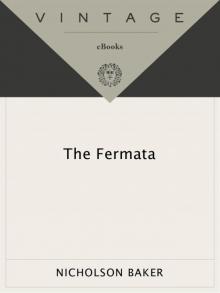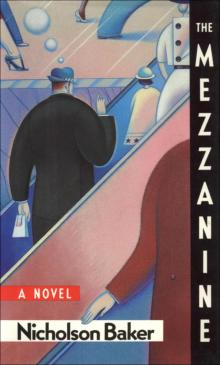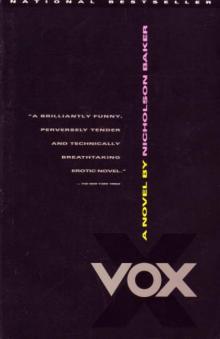- Home
- Nicholson Baker
The Everlasting Story of Nory Page 3
The Everlasting Story of Nory Read online
Page 3
The moral of the story about the child who was dipped in magical water was: nobody is one hundred percent immortal. Except God, for those who believed in God. The moral of the story about the painter was: you never know who will be famous and talented, so try not to get discouraged, and don’t allow handguns. The moral of the story about gray teeth was: sometimes by trying to do a good thing, you do a bad thing instead.
7. Fables in the Car
Aesop’s fables were where the idea of having a moral came from, but some of them made no sense whatever. Before bed, Nory’s parents read to her in alternation with each other, so one night her mother would read something, the next night her father. That first week of September, while Nory was listening to her mother read A Hundred and One Dalmations, she was listening to her father read Aesop’s Fables. He very often fell asleep a few minutes into reading. You could tell he was beginning a doze because he would start pronouncing the words in a hurrying murmur and then stop. Murmur, then stop, murmur, stop. And phrases would get into the story that had nothing to do with anything. If Nory gave him a nudge in the arm, he would bob awake and squinch his eyes shut very tight and flare them open them very wide and forge off into another page. Then very gradually his voice would fall away into a mutter again. ‘Seward’s folly hima hima hima cartouche hima hima Barcelona hima hima hima.’ Sometimes he read for pages that way, it was really quite remarkable, mixing giblet after giblet of totally unrelated nonsense into the story. ‘And the canisters could use some priming,’ is something that he said one time, in the middle of the story of the crow and the stones. Nory wrote it down and told them all at breakfast. If the story was good, Nory’s father didn’t fall asleep nearly as fast as if the story was going through a boring stretch. Then the nudging didn’t work and she finally had to say, ‘Daddy, you’re tired, aren’t you?’
‘How did you guess that?’ Nory’s father would ask, from deep in his doze.
‘Well, for one thing, the book seemed to be flopping.’
‘Was it flopping?’
‘Yes, it was.’
And then Nory’s father would say, ‘Well, I guess that just about wraps it up,’ and shut the book and say goodnight. The next time that it was his turn to read, he wouldn’t remember any of what he had already read, and he would go through several pages, saying ‘Did we read that? Did we read that?’ Nory usually could remember because she had a not-too-shabby memory for things that were read to her. It was very rare for Nory’s mother to fall asleep reading to Nory. Sometimes Nory almost fell asleep when she was reading to her dolls but almost never when she was being read to.
One night Nory’s father managed to read three Aesop’s fables in a row that just weren’t up to sniff. Aesop had had a very bad fable-writing day. Maybe the wax wasn’t smooth enough for him to concentrate. Nory’s father fell asleep after about ten minutes of reading and slept until Nory’s mother woke him up by coming in to give Nory a K and H and a G of W. That anagram stood for a ‘Kiss and a Hug and a Glass of Water.’ The next day, they drove to Wisbech to see Peckover House, a Stately Home, and on the way Nory had the idea of getting each one of them to think up a fable, as something to do in the car.
Her mother’s fable was about an ivy plant that overdoes himself and stays green year round, even through the freezing snows of winter. First he was evergreen for the pure joy of it, and then he was a little less happy and a little more bitter because the other plants failed to follow his lead of staying green and even made little jokes about the ivy plant and his odd winter habits. Finally the ivy got so upset with the rest of the garden for sleeping through the lonely cold months that his anger made his leaves turn brown at the edges and his tendrils stop uncurling. The gardener, who was used to his being green and healthy all year, pulled him up by the roots and threw him in the compost dump. And the moral was: Stay out of politics.
Nory’s father’s fable was about a cat who loved tuna catfood in cans and refused to eat the whitefish or the beef or the liver in cans, even though he was starvingly hungry, in order to try to force the girl who cared for him to give him tuna every day. The girl got so worried about the cat’s not eating that she took him to the vet. The vet said he was healthy, but he said that she must feed him only dry catfood from now on. And the moral was: He who wants only tuna, may end up with only dry.
Nory’s fable was about two Korean girls. Once there were two little Korean girls. Their parents had died in a car accident, because the ambulance had not had the Jaws of Life to use to save them. The Jaws of Life are, as you know, huge scissors that can cut through metal and pull an injured person from a car. So the poor, tired little girls were sent to an orphanage. There they put up signs that said ‘Help!’ because they were treated very badly. Seeing their signs, a kind woman, who wanted so much to have a little girl, adopted them. They were very grateful. But one day the mother, whose name was Nanelan, had to go to a different country to the Queen’s birthday party. She asked the only couple she could get in touch with to watch her children. But she did not know that these were evil people. The first day she was gone they spilled a puddle of water to make the children slip and hurt themselves and go to the hospital, so that they would not have to pay for the children’s food. The next night the couple, dancing with evil joy, fell into the puddle. Hearing this, the insurance company refused to pay the hospital, and the couple lost all the money. And the moral is: Do not be selfish or your curse will come back.
They asked Littleguy for a fable, too. He came up with two. His first fable was called ‘Bulldozer.’ Once upon time was a train. A train on a track. It saw a diesel train coming on the track, too, and they crashed. The two went kssssh! All the pieces came off they. The puff-puff broke, and the wheels broke, and the track broke. Everything broke. But they went to the shop and got fixed and they got painted, and went to the station and people came on them and they set off. The end.
Littleguy’s second fable was called ‘Browned.’ Once upon time was a bulldozer, pulling a trailer filled with all kinds of choo-choos, digger-trucks, and auger drillers, and dump trucks. And the other ones that have round things, cement mixers. The bulldozer saw a car pulling a trailer by it. And they didn’t crash, they just went right by they. The bulldozer drove and drove and drove and drove and drove and drove and drove. The bulldozer’s name was Browned. The end.
Since there were no morals in Littleguy’s two fables, Nory added them on. The moral of the first fable was: sometimes when there’s a crash, it turns out all right in the end. And the moral of the second one was: sometimes things don’t even crash at all.
At Peckover House, Nory got a National Trust eraser from the gift shop after they had tea.
8. About Debbie
Nory was proudly born in Boston, Massachusetts, in America. A lot of houses looked like Peckover House in Boston. Boston was old in a beautiful way and it was especially important to Nory because it was frankly the only city she had ever lived in, except Venice for three weeks when she was three years old, where she was baptized with a surprising splash of water in a huge cold church, holding her own candle, that later got broken and had to be thrown out even though it was wrapped in tissue paper. In Venice she also ate pitch-black spaghetti. The black was squid ink and it was quite good. Long ago, they used to use squid ink to make real ink, for using in Medium Nib fountain pens, but probably it would make a kind of ink that no ink eradicator would eradicate. Ink eradicators were made from pigskin and pig-waste, according to a girl at Threll Junior School, who said her sister once visited an eradicator factory.
Threll was just a town, not a city, and Palo Alto, California, was just a town, too, although it had quite a seedy neighborhood in the way that real cities do. You might imagine a French person going around Palo Alto, California, with an American person. The American would say, ‘As you will notice, there are some seedy areas.’ The French person would say, in his very strong French accent, ‘Oh, is this—city area?’ Pronouncing it of course the way the French t
eacher at the Junior School pronounced it. And the American would misunderstand and say sadly, ‘Yes, I’m afraid it is seedy. There’s just no getting around it.’ Maybe that’s how the idea that cities were seedy came about, if it happened quite a number of times. Also when people don’t cut their grass, it grows so long that it shoots out a tassel of seeds, which was a sign that the people in that house didn’t care about their yard. Maybe they were caring for a sick person who was cooped up in the house, or maybe they were busy giving themselves shots of drugs and alcohol and didn’t have the energy to walk out their front door and cut the grass. That’s another way the idea that cities were seedy could have come about.
Nory’s favorite street in Palo Alto had a number of stores on it, including the toy store. Nory spent half an hour there one Saturday in the summer while Littleguy played with the breakdown train at the Thomas the Tank Engine table. She looked through every one of the Barbie outfits, because her new best friend, Debbie, said she liked Barbies with black hair and blue dresses. Debbie had given Nory a friendship locket to celebrate that they were new best friends, and Nory was extremely happy about that and wanted to give Debbie a Barbie from money she earned selling hand-lettered signs to her parents. She looked and looked, and finally tucked away behind a whole lot of other outfits she found a dark blue Barbie dress with lighter blue sparkles on the front, and she hung it back on the hook as the very first one and went to get her mother. When she came back, though, another girl was there with her mother, and the girl was holding the blue dress outfit in her hand. Nory stood there and tried her best to hint by the sad hopeless way she was flopping her arms and looking at the blue dress in the girl’s hand that she had just spent a whole half an hour going through every outfit to find it, but the girl and her mother ignored her, or didn’t know what she was flopping about, and she didn’t want to say anything, because of course the girl had found it all by herself, it’s just that the girl wouldn’t have had hardly a chance of finding it if Nory hadn’t found it and put it on top where it got the special feeling of being the first outfit on display.
They went to another toy store a week later, but there were no blue dresses that were right. Blue was not in fashion at that moment. So Nory got Debbie a tiny glass panda bear posed on a branch, all made of droops of light blue glass, because Debbie was devoted to pandas and had about thirty of them in her room. Nory wrote Debbie a letter soon after they came to England that said:
Dear Debbie,
How ary you? How is your school? I went to the Fitz Willyham museum, where there was a fan room, and there is a fan launguage for things you’re not allowed to say in public if you place the fan behind your head it means ‘Don’t forget me’! There was a fan that I preticularly liked, It is made from coal and mother of peal. I went to Pecover House, but I think it should be famous for its garden more than the house. It has a wunderful statue of a girl and a dog made from stone, and a green house with a fern that will crumple-up when you touch it. I miss you and your dog Sharpy, how is that shoe consuming feind? I hope to be seing you again soon. Love Eleanor PS Please write back.
She drew a picture of a girl holding a fan behind her head at the bottom of the letter.
The best dream Nory had ever had was about Debbie. Nory had died, although she didn’t come to that conclusion until a different part of the dream. She whispered in Debbie’s ear, ‘Debbie, Debbie, it’s me.’ Debbie recognized Nory’s voice and looked up. Debbie had a very wide face, and she could get a look that was kind of still, kind of unnerved. Her mouth looked bigger because her lips were over the wiring of her braces. She made that unnerved look at Nory. She said, ‘Nory! Nory! Is that you?’ She recognized Nory’s voice, even though she couldn’t see her.
‘Don’t worry, Debbie,’ said Nory, in a calm gentle voice. ‘Don’t be scared. I would be too if I were you.’ Debbie seemed calmer. Nory showed her the newspaper, which said on the front page ELEANOR DIES IN A FIRE. Not her family, not anyone else. Later on in the dream Nory said Boo to Garrick, a kid in her class, sort of fakily: ‘Garrick? Boooooo!’
Garrick said, ‘No way, she can’t be a ghost, she’s dead already.’
‘Oh, yes I can!’ said Nory and fumed out in her full ghostiness. Garrick started running out of fear and tripped. That was funny because Garrick was a ten-year-old and usually extremely confident and pleased with himself and made fun of Nory’s spelling, which wasn’t very good. In fact it was a ‘bosaster,’ as Littleguy would say. But the wonderful part of the dream was when Debbie looked up, hearing the voice, and knew it was Nory nearby her.
9. A Strange Vegetable
‘It’s sometimes kind of impressive,’ Nory thought, ‘to try to envision how many bricks there are in a city.’ You could tell a city was old by the colors and crookedness of its bricks. In Boston Nory noticed that usually the bricks were red, but in Threll they were usually, not to be disrespectful, kind of a dirty yellow, and they were even less straight than in Boston. You wouldn’t expect dirty yellow crooked bricks to look pretty, but they did, especially where you could see places in the walls where there had been old windows or old doorways that had been stuffed with other bricks and stones and pieces of old buildings.
That was what a certain memory that you had forgotten felt like—you knew that a window had been there but it wasn’t now, just an old brick wall, so you couldn’t see through it. There was a very tall brick wall around the garden of the Bishop’s Palace at Threll, with pointy stones on top, so that the poor people couldn’t sneak in at night and steal the cauliflowers, which might have looked tempting in the moonlight to a very hungry mouthwatering person of long ago. At Waitrose, the supermarket, they sold darling little dwarf cauliflowers in the ‘Dwarf Food’ section. It wouldn’t be called dwarf food in America because that would hurt the feelings of a real dwarf, who would feel not too pleased about being compared to a vegetable.
Waitrose also sold a mysteriously pointy green plant, halfway between a cauliflower and a pine tree, called a Romanesco. Nory’s mother said that ‘Gothico’ would be a better name for it. It was intended to be eaten for dinner, but it looked like a screensaver on Nory’s mother’s computer called ‘Permafrost II.’ ‘Worms’ was the neatest of all the screensavers, though.
Nory gave the Romanesco to the Cathedral to be a part of the arrangement that was done by Threll School in the South Door, for the Harvest Festival. Kids had carried in carrots in bunches, and zucchini, which were called courgettes in Threll, and broccoli, apples, and sugar beets. But luckily nobody else in the school had given a Romanesco, which made hers easy to see. Nory’s father took three pictures of Nory in her school jacket and tie standing to one side of an open bag of potatoes. The potatoes were shaped just like the stones they put on either side of a lot of the sidewalks in Cambridge to remind your feet in a polite way that you were getting close to the grass. Cambridge was, as you may know, where you go to get a Ph.D. After they went to the Fitzwilliam Museum, in Cambridge, Nory told herself a story in the car, holding one of her dolls.
10. The Story of the Fan
One day, there was a little tiny baby. She was born too early, so she was really, really tiny. She should have gone into an incubator, but her parents weren’t rich enough, so she couldn’t. They just had to raise her as being a really, really small little person. She had a big soft-spot because she was so early. And her umbilical was too long. And so on. She was, on the whole, too small. Just a tiny little person.
When she was about three weeks old, she could already do her grasping. She couldn’t really turn yet, but she could turn her head, ever so slightly. She turned her head ever so slightly. She could almost grasp. She couldn’t have handled it yet, because that would be just impossible, so amazing that it would be a fairy tale, which this is, of course, but she seemed to be trying to grab for her mother’s fan. And ever since, she seemed to be totally interested in fans. Just completely interested in them. Her parents named her Colander.
When Colander was f
ull grown, she was a midget, because she was just a tiny person. When she was twelve, the tallest she ever was, she was as tall as Frank is. She was really short. So one day—it was really hard for her to go to school and museums and because people might tease her because she was so short—but one day they went to a museum. It had a lot of different things in it, china and armor and sculpture. They wandered here and there. She said: ‘I see that dark room. What’s in that dark room?’
They went into the dark room she had looked at. And there were the most beautiful fans that she had ever seen. So many different kinds, shapes, sizes. In the corner of each glass case was a little yellow box of some kind of mold killer to keep all the fans from being eaten by a strong fan-eating fungus.
But the fan that really caught her eye was one that was carved from mother-of-pearl, when you opened it up. When you closed it, it had beautiful ivory carvings of children, and then the ivory was put on top of jade. And there was beautiful gold-plating, where the hair of anything would be. For instance, if there was the hair of a mother it was gold-plated, all the hair was true gold plate. And there were also some diamonds put here and there on the fan. There were many other fine fans in the room, but that one was her total favorite.
She wanted most of all in the world to have it. She wanted to start a collection, and she wanted that fan in the centerpiece of it. That was all she wanted. She thought about fans, she drew pictures of the fan, in school she doodled ‘fan’ on her hand when she’d gotten totally bored with the conversation the teacher was giving to them. It was a long conversation in Latin and she hadn’t been studying Latin all that carefully because she was thinking about the fan. The fan was what entertained her.

 House of Holes
House of Holes Checkpoint
Checkpoint U and I
U and I The Fermata
The Fermata Substitute
Substitute The Size of Thoughts
The Size of Thoughts Mezzanine
Mezzanine The Anthologist
The Anthologist Traveling Sprinkler
Traveling Sprinkler Double Fold
Double Fold The Everlasting Story of Nory
The Everlasting Story of Nory Vox
Vox Vintage Baker
Vintage Baker A Box of Matches
A Box of Matches